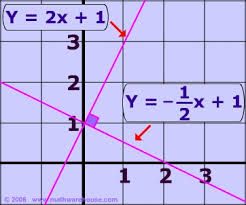Overview
Lines representing graphs of linear equations have slopes, defined as the change in y/change in x. Parallel lines have the same slope, but no solutions in common. Perpendicular lines intersect at one point to form right angles.
Finding Slopes of Parallel Lines
Imagine a line graphing the equation y = 2x +3. Using the slope-intercept formula y = mx +b, the equation has a slope of 2. Suppose another line exists graphing the equation y = 2x +5. Using the slope –intercept formula y = mx +b, that equation also has a slope of 2. The lines have no points in common, and they both have the same slope. Those lines are parallel. Lines that are not vertical are parallel if they have the same slope. Vertical lines, which have an undefined slope, are parallel by definition, as they do not intersect.
Finding Slopes of Perpendicular Lines
Lines that are perpendicular intersect at one point to form right angles, measuring 90 degrees. Not all lines that intersect are perpendicular. Vertical lines are perpendicular to horizontal lines by definition. For example, lines represented by the equations y = -2 and x = 4 are perpendicular. Lines that are not vertical are perpendicular only if the product of their slopes equals -1. Suppose a line y = 2/3x +1 and another line y= -3/2x +2. They will meet at one point and be perpendicular to each other. The product of their slopes (2/3) (-3/2) equals -1.
Are Lines Parallel or Perpendicular?
Sometimes math problems present the coordinates of points along a line, rather than the slope-intercept formula. The slopes of the lines can be calculated using the slope formula, then compared. If the slopes are the same, they are parallel. If the product of their slopes equals -1, they are perpendicular. Suppose one line passes through the points (0, 2) and (-3, -3) and another line passes through the points (4, 2) and (1, -3). The slope of the first line is given by the equation for the slope (-3 -2)/ (-3-0) or -5/-3. The slope of the second line is given by the equation (-3-2)/(1-4) or -5/-3. The lines are parallel.
Geometry Applications
The algebra of slopes of parallel and perpendicular lines can be applied to geometric forms. Since parallel lines have the same slope, lines of a parallelogram can be shown to be parallel. Suppose the coordinates of point A are (0, 2); point B (4, 2); point C (1, -3), and point D (-3, -3). A figure drawn on ABCD is a parallelogram, because lines AD and BC are parallel, and lines AB and CD are parallel.
Interested in math tutoring services? Learn more about how we are assisting thousands of students each academic year.
SchoolTutoring Academy is the premier educational services company for K-12 and college students. We offer tutoring programs for students in K-12, AP classes, and college. To learn more about how we help parents and students in Columbia, SC: visit: Tutoring in Columbia, SC




